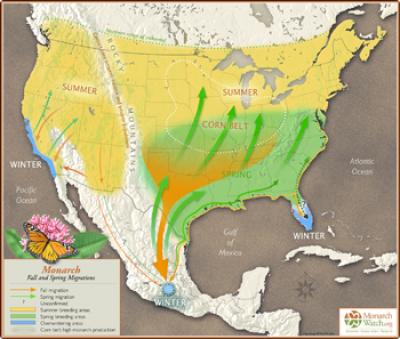Wonder Lake joins the Mayor’s Monarch Pledge program
Eastern Monarchs
Decreasing day length and temperatures, along with aging milkweed and fewer nectar sources trigger a change in monarchs; this change signifies the beginning of the migratory generation. Unlike summer generations that live for two to six weeks as adults, adults in the migratory generation can live for up to nine months. Most monarch butterflies that emerge after about mid August in the eastern U.S. enter reproductive diapause (do not reproduce) and begin to migrate south in search of the overwintering grounds where they have never been before. From across the eastern U.S. and southern Canada, monarchs funnel toward Mexico. Along the way, they find refuge in stopover sites with abundant nectar sources and shelter from harsh weather. Upon reaching their destination in central Mexico beginning in early November, monarchs aggregate in oyamel fir trees on south-southwest facing mountain slopes. These locations provide cool temperatures, water, and adequate shelter to protect them from predators and allow them to conserve enough energy to survive winter. In March, this generation begins the journey north into Texas and southern states, laying eggs and nectaring as they migrate and breed. The first generation offspring from the overwintering population continue the journey from the southern U.S. to recolonize the eastern breeding grounds, migrating north through the central latitudes in approximately late April through May. Second and third generations populate the breeding grounds throughout the summer. It is generally the fourth generation that begins where we started this paragraph, migrating through the central and southern U.S. and northern Mexico to the wintering sites in central Mexico.
The Village is drawing attention to the nationwide decline of the monarch butterfly and will act locally to do our part to help reverse this decline. We encourage residents to add monarch friendly native plants to their gardens that will provide food and shelter for migrating individuals, and will participate with local clubs and subdivisions to promote such activity. The Nippersink Watershed Association (NWA) is working on a number of sites with the Village of Wonder Lake. One site we are developing is along Birchwood drive in Wonder View. We are in the process of removing invasive trees
and shrubs that impede the growth of native pollinators. This is usually a wet area, serving as water retention for the subdivision, and a large area of sedge grasses fills most of the site. We have already started throwing seeds collected from native sites in the area, stay tuned. Creating localized pollinator sites within subdivisions is an effective way to attract monarchs and other native pollinators throughout the Wonder Lake community.
On a larger scale, the Village has acquired the property on Wonder Lake Road at Oakwood Shores. You may have noticed that on the north side of Oakwood Shores Dr we have established the site for the Wonder Lake Garden Club. Three 60’ by 5’ stripes have been made ready for residents who want to garden and need the space (one resident had an outstanding garden last summer). The property to the north of Oakwood Shores Dr is mainly and upland area perfect for milkweed and other native pollinators that the Village is working on.
Areas where spray irrigation is applied also make excellent sites to enhance with native pollinators.
All of these sites require community support, ANYONE interested in working with us to develop, mentor, steward, maintain, (etc) a local site is encouraged to contact Dennis Palys at dpalys@wlvillage.org.

